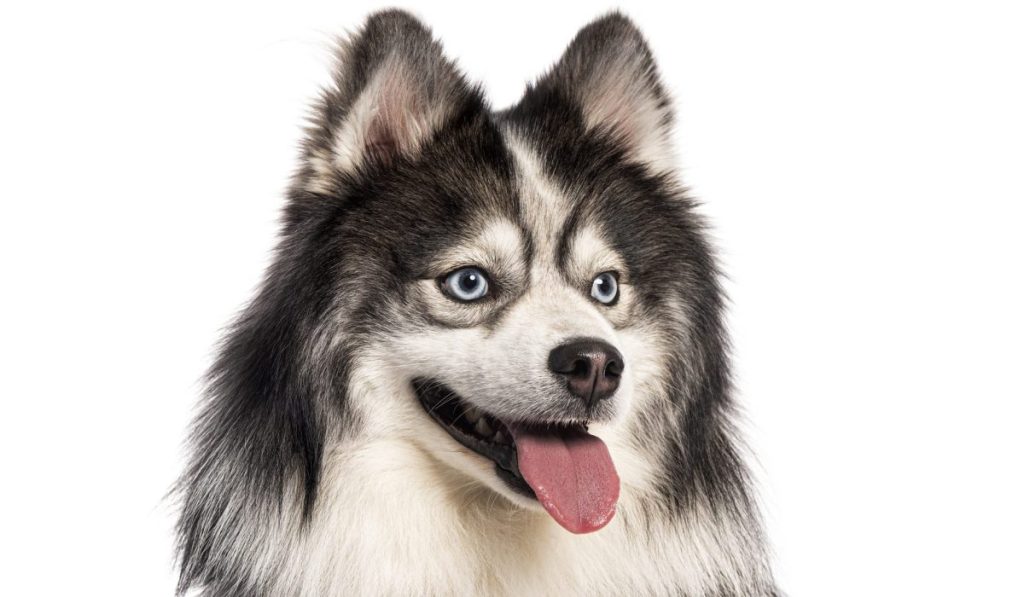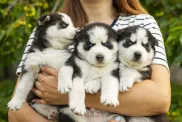The Pomsky is a small-sized designer breed resulting from a cross between the Siberian Husky and the Pomeranian, the smallest of the Spitz breeds. This adorable hybrid inherits the Husky’s striking wolf-like appearance and the Pomeranian’s compact, manageable size, creating a dog that often looks like a miniature Husky with the expressive, fluffy charm of their Pomeranian parent. Known for their playful, affectionate, and sometimes silly personalities, Pomskies have a natural knack for drawing attention and are well-suited to families, singles, and apartment living alike. Their social, energetic nature makes them ideal companions for those who enjoy a pet that’s involved in their day-to-day life.
However, there’s more to Pomskies than their good looks. They often require a considerable amount of attention, both in terms of mental stimulation and physical activity. Pomskies are highly intelligent, a trait inherited from their Husky lineage, but they can also be stubborn and mischievous, which makes training a challenge for inexperienced owners. They are natural problem-solvers, and without proper guidance, this can sometimes translate to escape attempts or getting into household mischief. With the right approach, however, they respond well to positive reinforcement and consistency, making training possible, though it can require more patience than with some other small breeds.
Pomsky characteristics
- Height: 10 to 15 inches at the shoulder
- Weight:7 to 38 pounds
- Lifespan: 12 to 15 years
Coat and color variations
Pomskies have a double coat that typically combines the Husky’s dense, weather-resistant outer coat with the Pomeranian’s fluffier texture, resulting in thick, plush fur that varies in softness and length. Their coat colors are highly diverse, thanks to the influence of both parent breeds. Pomskies come in shades including black, white, gray, brown, cream, and even more striking combinations, like the classic Husky black-and-white or red-and-white pattern. Many also inherit the Husky’s unique facial mask markings, adding to their miniature Husky appearance, while others display a more solid or blended coat pattern similar to the Pomeranian. Some Pomskies even exhibit rare blue or heterochromatic eyes.
Physical traits and appearance
The Pomeranian Husky mix tends to be smaller in size, but can sometimes be classified as a medium-sized breed if they take after their Siberian Husky parent.
Pomsky sizes
Size: Pomskies typically stand between 10 to 15 inches tall at the shoulder and weigh between 15 and 30 pounds, though their size can vary depending on the proportion of genes inherited from each parent.
- Toy: Weighs up to 15 lbs and is less than 10 in tall at the shoulder
- Mini: Weighs 12–20 lbs and stands up to 14 in tall at the shoulder
- Standard: Weighs 20–35 lbs and is 12–18 in tall at the shoulder
Body Shape: Compact and athletic, Pomskies are generally well-proportioned with a medium-length body and a sturdy, muscular build. They tend to have a balance of Husky robustness and Pomeranian lightness, making them agile and sprightly.
Facial features and other attributes
- Head and Face: They have a distinct wedge-shaped head, often with an expressive fox-like or wolf-like appearance. Pomskies often inherit the Pomeranian’s alert, perked ears, though some may have slightly larger, Husky-like ears.
- Eyes: One of their standout traits, Pomskies can have a range of eye colors, including brown, blue, amber, or even heterochromatic (two different colored) eyes, a trait passed down from the Husky parent.
- Tail: Like both parent breeds, Pomskies often have a curled tail that sits high over their back and is thickly furred, adding to their fluffy and animated appearance.
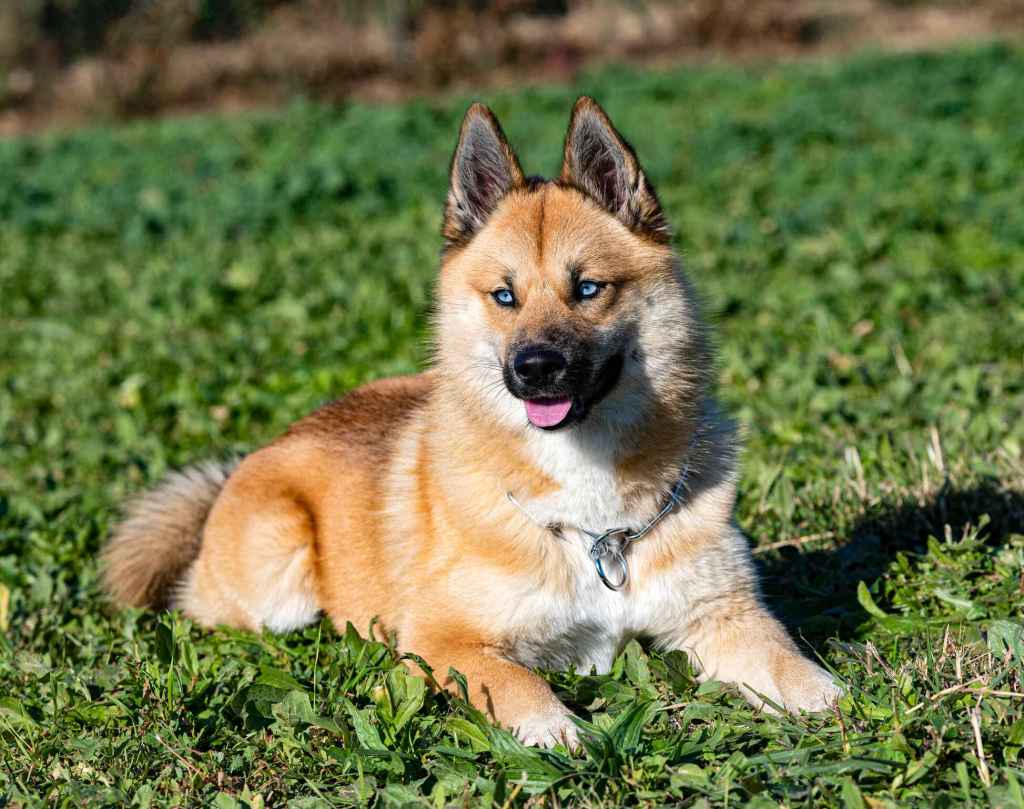
Pomsky history
In 2011, Buzzfeed inadvertently helped with the creation of the Pomsky dog breed by posting a fake article intending to go viral with pictures of a dog that didn’t exist. Breeders sought to create a small, family-friendly dog that combined the striking appearance of the Siberian Husky with the compact size and charm of the Pomeranian. They successfully crossed these two breeds to produce the first Pomskies, sparking interest due to their “miniature Husky” look and friendly nature.
Since then, the Pomsky has grown in popularity, especially among urban dwellers who want a dog with the Husky’s striking features in a more manageable size. While they’re not yet recognized by major kennel clubs, Pomskies are beloved for their unique appearance and spirited personality, and they continue to gain a following around the world.
Pomsky personality
The Pomsky’s personality is a blend of the Siberian Husky’s spirited energy and the Pomeranian’s playful, affectionate nature. These dogs are lively, engaging, and often love being the center of attention, making them a good match for social owners who enjoy interacting with their pets. While small in stature, they have big personalities and are known to be curious, clever, and sometimes a bit mischievous.
Pomskies are highly alert and can be both vocal and expressive, using their “voices” to communicate with their families in a charming, almost talkative way. They’re happiest in homes where they receive plenty of mental and physical stimulation, as boredom can lead to some less desirable behaviors.
Temperament and behavior
- Energetic: Pomskies are high-energy dogs who love to play and be active. They benefit from regular walks, playtime, and opportunities to engage in stimulating activities.
- Intelligent and Curious: They are quick learners but also have an inquisitive, sometimes independent, nature that can make training a bit challenging, especially for first-time dog owners.
- Affectionate: Pomskies tend to bond closely with their families and enjoy being around people. They are often described as “velcro dogs,” following their owners around the house.
- Vocal and Expressive: With a mix of barks, whines, and sometimes even howls, Pomskies are known for “talking” to their families, especially when they want attention or feel left out.
- Playful: They retain a puppy-like playfulness well into adulthood, making them great for families with children or other pets, as long as introductions are done carefully.
- Protective: Though not typically aggressive, Pomskies can be alert and watchful, making them good at alerting their families to strangers or unusual noises.
- Stubborn Streak: Due to their Husky lineage, Pomskies can be independent and may test boundaries, especially during training, requiring patience and consistency from their owners.
Training and socialization
Early socialization and positive reinforcement training are crucial due to their intelligence and potential stubbornness. Of course, their intelligence allows them to pick up commands quickly, so early training is key to establishing good behavior from the start. Use praise, treats, and affection to reward desired behavior. Pomskies respond well to positive reinforcement, and this approach will keep them motivated and engaged.
Training tips:
- Be Consistent: Consistency is crucial in training. Use the same commands and routines to avoid confusion. This helps your Pomsky understand what is expected of them.
- Keep Training Sessions Short and Fun: Pomeranian Huskies are intelligent but can lose interest if training sessions are too long or repetitive. Keep sessions short (10-15 minutes) and engage with varied activities.
- Mental Stimulation: Incorporate puzzle toys, obedience training, and interactive games into their routine to challenge their mind. A bored Pomsky can become restless or destructive. Once basic obedience is established, teach more advanced commands or tricks. Their intelligence makes them excellent candidates for agility training and fetch.
Pomsky care
Caring for a Pomsky involves meeting their physical, mental, and social needs. These high-energy dogs require daily exercise, whether through brisk walks, interactive play, or engaging in games that tap into their intelligence, like puzzle toys or training exercises. Mental stimulation is essential, as their curious nature can lead them into mischief if they’re bored. Pomskies thrive on interaction with their families and benefit from consistent training to help channel their spirited personality and sometimes stubborn tendencies. Additionally, their close attachment to their family members means they don’t enjoy long periods alone, so they’re best suited to homes where they have companionship and attention.
Pomsky grooming needs
With their thick double coat, Pomskies require regular grooming to manage shedding and keep their fur in top condition. While their coats are low-maintenance in some ways, the Pomsky’s seasonal shedding calls for extra care to prevent matting and control loose fur around the house.
How to groom a Pomsky
Coat care
- Brushing: Pomskies should be brushed at least two to three times a week, and daily during shedding seasons (spring and fall). Use a slicker brush or an undercoat rake to work through their dense fur, removing dead hair and preventing tangles.
- Bathing: Bathe a Pomsky every 6 to 8 weeks or as needed, using a gentle dog shampoo to protect their skin and coat. Overbathing can dry out their skin, so keep it minimal unless they get particularly dirty.
- Shedding Control: During shedding season, consider using a de-shedding tool to manage excess fur and reduce shedding around the house.
Nails, ears, and teeth
- Nail Trimming: Regularly trim their nails, typically every 3 to 4 weeks, as long nails can be uncomfortable and impact their gait.
- Ear Cleaning: Check their ears weekly for wax buildup, dirt, or signs of infection. Use a dog-specific ear cleaner and cotton ball to gently clean around the visible ear canal.
- Dental Care: Brush their teeth a few times a week to promote good oral health, as smaller breeds can be prone to dental issues.
Flea, tick, and parasite control
Keep up with flea and tick prevention treatments, especially if your Pomsky spends much time outdoors. Regular grooming allows you to spot parasites early.
Early acclimation is key
Getting your Pomsky accustomed to grooming procedures from a young age makes the process easier and more enjoyable for both of you. Handle their paws frequently, examine their mouth and ears, and reward them for good behavior during grooming sessions. This positive foundation sets the stage for stress-free veterinary exams and handling throughout their lives.
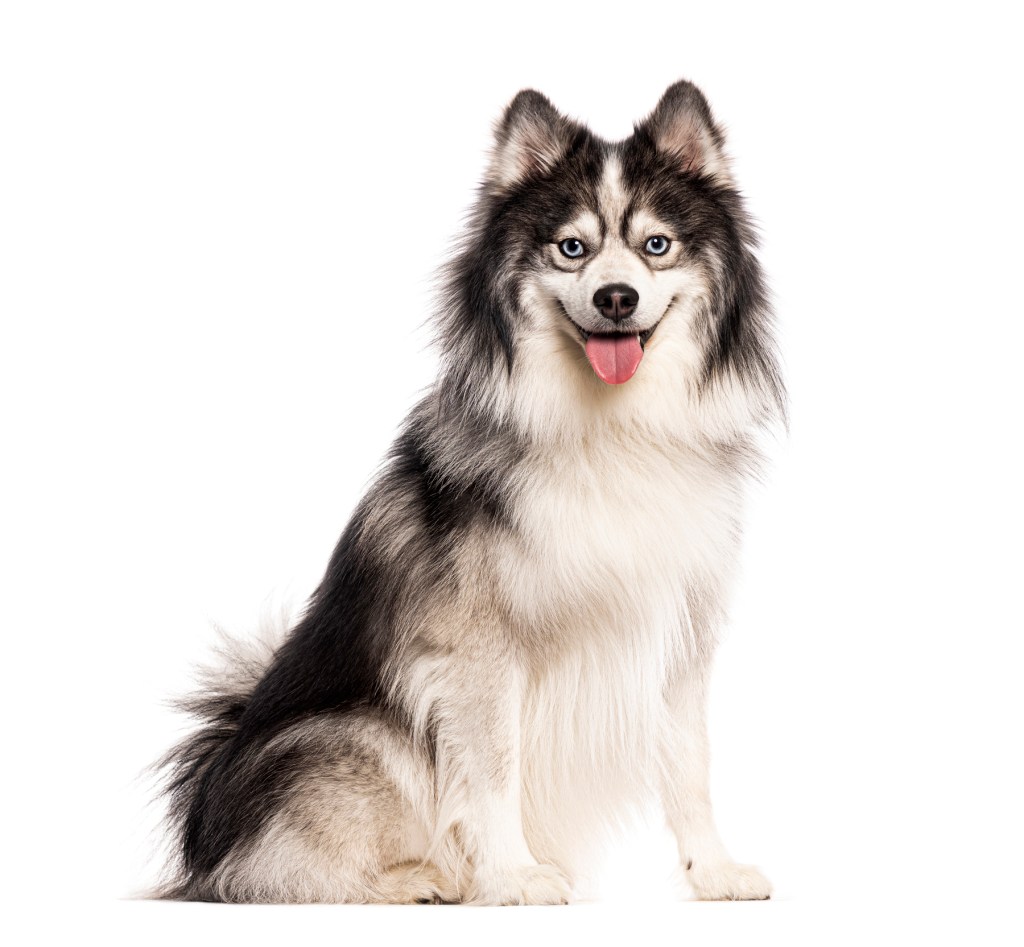
Does the Pomsky shed a lot?
Pomskies shed a considerable amount, especially during seasonal shedding periods in the spring and fall. They have a dense double coat that sheds year-round, with a noticeable increase during these times as they “blow” their undercoat to adjust to changing temperatures. Regular brushing is essential to manage the shedding, reduce loose fur around the house, and prevent matting. Using an undercoat rake or de-shedding tool can help keep their shedding under control, particularly during heavy shedding seasons.
Pomsky feeding and nutrition
Pomsky feeding and nutrition require attention to portion control, as these dogs can be prone to overeating and weight gain due to their smaller size and often enthusiastic appetite. Portion sizes should be based on their age, weight, activity level, and individual metabolism, but generally, Pomskies do well on a high-quality, balanced dog food formulated for small—to medium-sized active breeds.
Portion size guidelines:
- Puppies: Pomsky puppies are growing rapidly and have higher energy needs, so they typically require about 1 to 1.5 cups of food daily, divided into three meals. Puppies need more frequent feeding schedules to maintain stable energy levels.
- Adults: Adult Pomskies usually require between 3/4 to 1.5 cups of food per day, depending on their weight and activity level, divided into two meals. For more accurate portion size, follow the specific feeding guidelines on your dog food label, adjusting as needed based on body condition and activity.
- Senior Dogs: Senior Pomskies may have lower calorie needs, so portion sizes should be adjusted to avoid weight gain. Typically, about 3/4 to 1 cup per day is a good starting point, with adjustments based on their activity level and health.
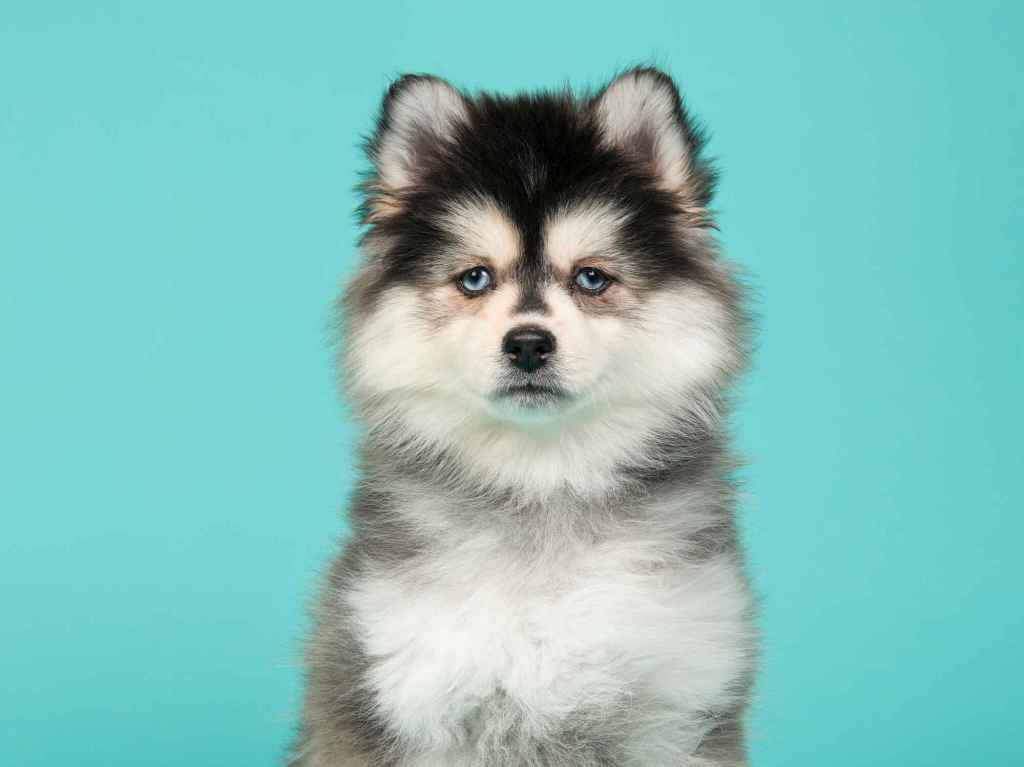
Pomsky family compatibility
Pomskies can make excellent family pets due to their affectionate, playful, and social nature. Their size and temperament are often a good fit for families, as they love being around people and tend to bond closely with their owners. Energetic and always eager for attention, they thrive in homes where they can be involved in family activities, whether it’s going for a walk, playing games, or just hanging out at home. However, because Pomskies can be somewhat high-energy and occasionally stubborn, they need consistent training and structure, which helps them understand boundaries and feel more secure. They do best in families that can dedicate time to their care and provide the attention, exercise, and mental stimulation they require.
Does the Pomsky get along with children?
Yes, Pomskies can get along well with children, especially if they’re introduced to kids at an early age. Their playful and affectionate personalities make them fun companions for kids, and they often enjoy the lively energy children bring. However, due to their small to medium size, they can be sensitive to rough handling, so it’s essential to teach children to interact gently and respectfully with the dog. Supervised playtime is recommended, especially with younger children, to ensure that both the dog and child stay safe and comfortable.
Pomsky health issues
Pomskies are generally healthy dogs, but they can be prone to some health problems, just like any other dog breed. Some of the most common health problems that Pomskies can suffer from include:
- Hip dysplasia: This is a condition in which the hip joint does not fit together properly, causing pain and lameness.
- Elbow dysplasia: This is a similar condition that affects the elbow joint.
- Bloat: This is a life-threatening condition that occurs when the stomach twists, cutting off blood flow.
- Eye problems: Pomskies can be prone to a variety of eye problems, such as cataracts, glaucoma, and progressive retinal atrophy (PRA).
- Allergies: Pomskies can be prone to allergies, both environmental and food allergies.
- Skin problems: Pomskies can also be prone to skin problems, such as hot spots and allergies.
- Degenerative disc disease: This is a condition that affects the discs in the spine and can cause pain and lameness.
- Heart disease: Pomskies can be prone to a variety of heart problems, such as mitral valve disease and aortic stenosis.
It is important to take your Pomsky to the vet for regular checkups to catch any potential health problems early. You should also be aware of the signs and symptoms of these health problems so that you can seek treatment promptly if necessary.
Pomsky rescue groups
You should always consider rescue or adoption from shelters, as buying from breeders only encourages overpopulation and leaves shelter dogs without homes. Several rescue groups all over the country specifically help Pomeranians, Siberian Huskies, and mixes of those breeds, including Pomskies.
If you decide to purchase a Pomsky puppy, thorough research into reputable breeders is crucial. The popularity of Pomskies has led to an increase in unethical breeding practices, with many backyard breeders and puppy mills seeking to capitalize on the breed’s trendy status. These breeders often prioritize profit over the health, temperament, and well-being of their dogs, leading to puppies that may suffer from health or behavioral issues due to poor breeding practices and lack of proper care.
A responsible breeder will provide health clearances for both the Husky and Pomeranian parents, have a clean and caring breeding environment, and allow you to meet the puppy’s parents if possible. They should be transparent about the breed’s needs, and potential challenges, and be willing to answer your questions about Pomsky care. By choosing a reputable breeder, you not only support responsible breeding practices but also increase the likelihood of bringing home a healthy, well-socialized Pomsky.
How much are Pomsky puppies?
Pomsky puppies typically range from $1,500 to $5,000, with prices depending on factors like the breeder’s reputation, the puppy’s lineage, coat and eye color, size, and location. Unique features, such as blue or heterochromatic (two different colored) eyes, Husky-like markings, or a particularly fluffy coat, can drive up the price. Additionally, first-generation Pomskies (those directly from a Husky and Pomeranian parent) are often more expensive due to the breeding complexity. Due to the high demand for Pomskies, it’s essential to choose a reputable breeder who prioritizes health and responsible breeding practices over aesthetic traits alone.

